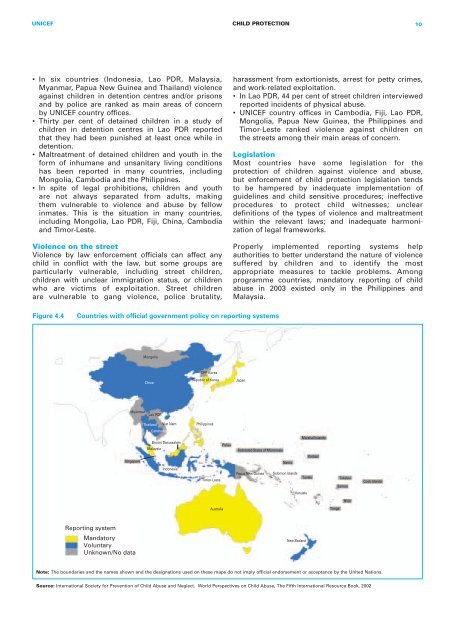CHILD PROTECTION - Unicef
CHILD PROTECTION - Unicef
CHILD PROTECTION - Unicef
You also want an ePaper? Increase the reach of your titles
YUMPU automatically turns print PDFs into web optimized ePapers that Google loves.
UNICEF<br />
<strong>CHILD</strong> <strong>PROTECTION</strong><br />
10<br />
• In six countries (Indonesia, Lao PDR, Malaysia,<br />
Myanmar, Papua New Guinea and Thailand) violence<br />
against children in detention centres and/or prisons<br />
and by police are ranked as main areas of concern<br />
by UNICEF country offices.<br />
• Thirty per cent of detained children in a study of<br />
children in detention centres in Lao PDR reported<br />
that they had been punished at least once while in<br />
detention.<br />
• Maltreatment of detained children and youth in the<br />
form of inhumane and unsanitary living conditions<br />
has been reported in many countries, including<br />
Mongolia, Cambodia and the Philippines.<br />
• In spite of legal prohibitions, children and youth<br />
are not always separated from adults, making<br />
them vulnerable to violence and abuse by fellow<br />
inmates. This is the situation in many countries,<br />
including Mongolia, Lao PDR, Fiji, China, Cambodia<br />
and Timor-Leste.<br />
Violence on the street<br />
Violence by law enforcement officials can affect any<br />
child in conflict with the law, but some groups are<br />
particularly vulnerable, including street children,<br />
children with unclear immigration status, or children<br />
who are victims of exploitation. Street children<br />
are vulnerable to gang violence, police brutality,<br />
harassment from extortionists, arrest for petty crimes,<br />
and work-related exploitation.<br />
• In Lao PDR, 44 per cent of street children interviewed<br />
reported incidents of physical abuse.<br />
• UNICEF country offices in Cambodia, Fiji, Lao PDR,<br />
Mongolia, Papua New Guinea, the Philippines and<br />
Timor-Leste ranked violence against children on<br />
the streets among their main areas of concern.<br />
Legislation<br />
Most countries have some legislation for the<br />
protection of children against violence and abuse,<br />
but enforcement of child protection legislation tends<br />
to be hampered by inadequate implementation of<br />
guidelines and child sensitive procedures; ineffective<br />
procedures to protect child witnesses; unclear<br />
definitions of the types of violence and maltreatment<br />
within the relevant laws; and inadequate harmonization<br />
of legal frameworks.<br />
Properly implemented reporting systems help<br />
authorities to better understand the nature of violence<br />
suffered by children and to identify the most<br />
appropriate measures to tackle problems. Among<br />
programme countries, mandatory reporting of child<br />
abuse in 2003 existed only in the Philippines and<br />
Malaysia.<br />
Note: The boundaries and the names shown and the designations used on these maps do not imply official endorsement or acceptance by the United Nations.<br />
Source: International Society for Prevention of Child Abuse and Neglect. World Perspectives on Child Abuse, The Fifth International Resource Book, 2002

















